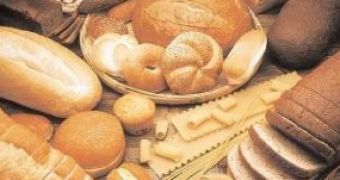A new study, that has investigated the various types of diets existing nowadays, found that diets that are high in carbohydrates and have a low glycemic index are the most efficient in reducing fat mass.
These diets based on consuming high amounts of carbohydrates with a low glycemic index showed to work as good against excessive weight as diets on proteins. However, low glycemic index diets also reduce levels of "bad" or "unfriendly" cholesterol within our bodies, decreasing therefore the risk of cardiovascular disease, stroke or heart attack.
For the research, a medical team from University of Sydney, Australia, has tested 4 different types of diets on 129 volunteers that were obese adults with ages ranging from 18 to 40. All four diets were reduced calorie and fat diets. Two of them were high carbohydrates diets, one with a high glycemic load and one with a low glycemic load; the other two types of diets were high-proteins diets, one with a high and one with a low glycemic load. The glycemic load refers to the total contribution of all foods in a diet to blood glucose levels.
In a nutshell, there were low glycemic load diets on proteins and on carbohydrates and high glycemic load diets also on proteins and on carbohydrates. The 129 volunteers were assigned one of the four types of diets randomly. They have been on the assigned diet for a 12 week period.
The results showed that all the individuals that participated in the study lost weight, but differently. Of the adults who had been on carbohydrate diets, the ones on low glycemic index diet lost almost the double amount of fat mass as compared to those on the high glycemic index diet. This did not happened in the case of people that had been on high protein diets. People that have been on the high protein, high glycemic load experienced an increase in the levels of "bad" cholesterol in their bodies. On the other hand, the ones that had been on high protein and high carbohydrates diets with low glycemic load showed a decrease in the "bad" cholesterol levels.
"In conclusion, at least in the short term, our findings suggest that dietary glycemic load, and not just overall energy intake, influences weight loss and postprandial glycemia (blood sugar levels after eating). Moderate reductions in glycemic load appear to increase the rate of body fat loss, particularly in women. Diets based on lowglycemic index whole grain products (in lieu of whole grains with a high glycemic index) maximize cardiovascular risk reduction, particularly if protein intake is high. Reassuringly, this advice can optimize clinical outcomes within current nutrition guidelines, without the concerns that apply to low-carbohydrate diets," stated Joanna McMillan-Price, leader of the study.
Carbohydrates represent a group of nutrients that contain carbon atoms that have been hydrated by adding water molecules. They are made of sugar molecules, called saccharides and include sugars, starches, and fiber. Both sugars and starches are broken down by the body into the simple sugar, glucose. After being formed, glucose molecules circulate in the bloodstream, supplying cells with fuel.
Carbohydrates are usually classified in simple or complex, depending on their chemical structure: simple carbohydrates have one or two chains of sugar, while the complex ones have three or more such chains.
Simple carbohydrates include fructose (found in fruits), galactose (milk), lactose (dairy products), maltose (vegetables and beer) and sucrose (table sugar and honey.) Complex carbohydrates, or starch, are to be found in foods like bread, cereals, rice, pastas, and starchy vegetables - corn, potatoes, peas etc.
Low glycemic index relate to how quickly the food is broken down by our body after it has been consumed. Generally, complex carbohydrates have low glycemic index.
Dr. Simin Liu, from the University of California in Los Angeles commented upon the study: "foods with a low degree of starch gelatinization, such as pasta, and those containing a high level of viscous soluble fiber, such as wholegrain barley, oats, and rye, have slower rates of digestion and lower glycemic index values. Therefore, without any drastic change in regular dietary habits, one can simply replace high glycemic index grains with low glycemic index grains and starchy vegetables with less starchy ones and cut down on softdrinks, that are often poor in nutrients yet high in glycemic load."

 14 DAY TRIAL //
14 DAY TRIAL // 
